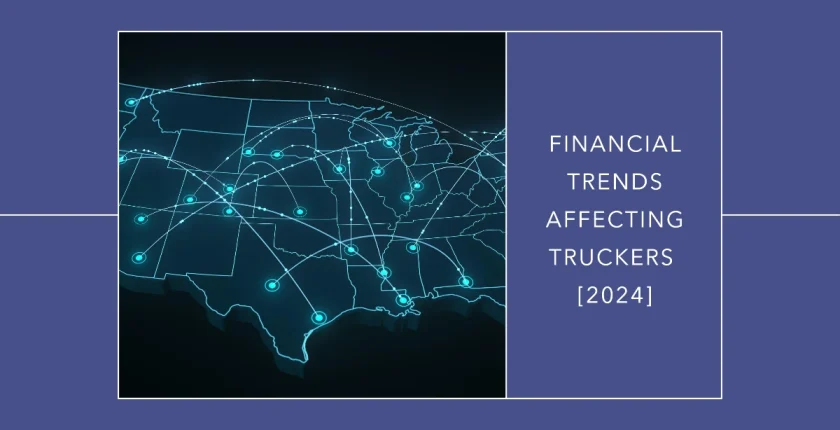Financial Trends Affecting Truckers: Economic of the Trucking Industry [2024]
Trucking Operational Costs per Mile
We find that the trucking industry continues to be a critical component of the U.S. economy, generating over $700 billion in annual revenue. The sector faces several financial challenges, with rising operational costs being a significant concern. The cost of operating a truck reached a record high in 2022, increasing to $2.251 per mile, marking the first time in history that operational costs per mile have surpassed the $2.000 mark. This increase is attributed not only to fuel costs, which saw a nearly 54% increase across the industry, but also to other factors such as repair and maintenance, truck and trailer payments, auto liability insurance premiums, tires, and notably, driver wages.
| Year | Operational Costs per Mile ($) | Fuel Costs Increase (%) | Driver Wages Increase (%) | Insurance Premiums Increase (%) | Driver Shortage | Environmental Impact – Diesel Consumption (Billion Gallons) | Sources |
|---|---|---|---|---|---|---|---|
| 2020 | ~2.10 (est.) | 14% | 3.6% | Data unavailable (industry reports for trends) | 61,000 (ATRI) | 52.1 | EIA, BLS, ATRI |
| 2021 | ~2.20 (est.) | 27.8% | 5.4% | Data unavailable (industry reports for trends) | 80,000 (ATRI) | Data unavailable | EIA, BLS, ATRI |
| 2022 | 2.25 | 154% | 16% | Data unavailable (industry reports for trends) | 78,000 (ATA) | Data unavailable | ATA, Trucking.org, |
| 2023 (est.) | 2.40 | 20% | 9% | 12% | 64,000 (projected) | 54.3 | ATA, Trucking.org, |
– Operational costs are estimates based on ATRI data and adjusted for inflation and fuel costs.
– Fuel costs are increases calculated using EIA’s diesel price data.
– Driver wages are increases calculated using BLS data.
– Insurance premiums are unavailable for specific years, so references to industry reports are provided.
– Driver shortage figures are from ATRI and ATA reports.
– Environmental impact data for 2021 is unavailable.
– Sources are listed for each data point for further information.
– Remember that some data points are estimates or projections based on available information. For the most up-to-date and specific data, it’s recommended to consult specialized industry reports and government sources.
Truck Driver Wages
Driver wages, in particular, have seen a significant increase, rising by about 16% over the past year, the fastest rate of increase since data collection began. This rise in wages is a response to the truck driver shortage, which, while expected to decrease by 20% from 78,000 in 2022 to 64,000 in 2023, remains a pressing issue for the industry. The shortage is projected to lead to a demand for 82,000 drivers in 2024 and 160,000 by 2028 as freight demand increases and the current workforce ages.
Trucking Environmental Impact
The environmental impact of the trucking industry is also under scrutiny, with the sector consuming around 54.3 billion gallons of diesel fuel annually and being a significant contributor to greenhouse gas emissions in the U.S. In response, there is a growing focus on reducing environmental impact through the adoption of alternative fuels and technologies such as electric and hybrid vehicles.
Trucking Insurance Premiums
Insurance premiums have increased by 47% between 2010 and 2023, driven by rising payout and litigation costs. This rise in insurance costs, alongside the other operational expenses, poses financial challenges for trucking companies of all sizes, from large fleets to small operators. Small fleets, making up nearly 96% of registered motor carriers, face unique challenges related to their size, including higher insurance premiums and operational costs compared to their larger counterparts.
Trucking Industry in 2024 – Predictions
Predicting the Operational Costs per Mile ($) for the trucking industry in 2024 involves considering several key factors, including fuel prices, driver wages, insurance premiums, and investments in technology. Given the trends up to 2023, where operational costs reached a record high in 2022 at $2.251 per mile, we can infer several potential influences for 2024:
- Fuel Prices: With fluctuating oil markets and the push towards greener alternatives, fuel costs will continue to be a significant factor. If the industry accelerates its adoption of fuel-efficient or electric vehicles, this could mitigate some of the fuel cost pressures. However, given global economic trends and potential geopolitical issues, if fuel prices continue to rise or remain volatile, this could exert upward pressure on operational costs.
- Driver Wages: The industry’s efforts to address the driver shortage through increased wages will likely continue into 2024. Higher wages, while necessary for attracting and retaining drivers, will contribute to rising operational costs unless offset by gains in efficiency or other areas.
- Insurance Premiums: Insurance costs have been on an upward trajectory, influenced by factors such as litigation costs and the value of cargo. Without significant improvements in safety technology adoption and a reduction in the number and severity of accidents, insurance premiums could continue to rise, further impacting operational costs.
- Technology and Efficiency Improvements: Investments in technology—such as autonomous driving aids, advanced fleet management software, and more efficient vehicles—can help reduce some operational costs over time. The extent to which these technologies are adopted and their impact on reducing costs like maintenance and fuel will be critical.
Considering these factors, if fuel prices remain high or increase, driver wages continue to rise, and insurance premiums do not stabilize, the operational costs per mile could see a further increase in 2024 beyond the $2.251 mark recorded in 2022. A cautious prediction would place operational costs per mile slightly higher in 2024, potentially in the range of $2.30 to $2.50, accounting for inflationary pressures and the factors mentioned above. This estimate assumes moderate increases in fuel costs and driver wages, continued high insurance premiums, and gradual adoption of cost-saving technologies.
